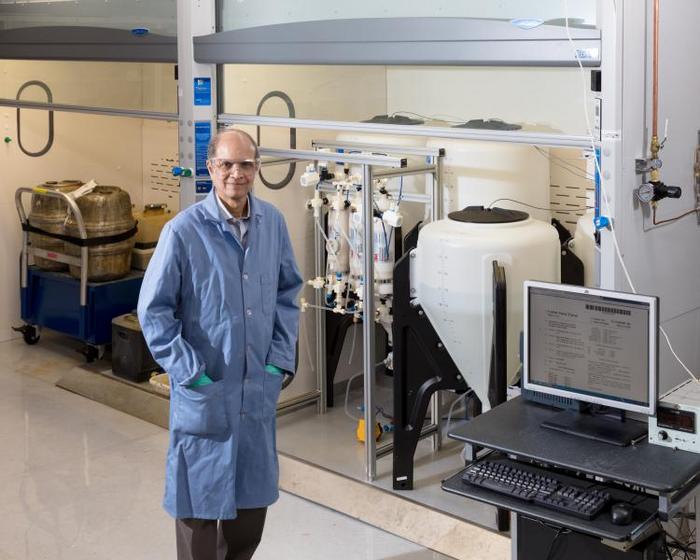Caldera Holding, the owner and developer of Missouri’s Pea Ridge iron mine, has entered a nonexclusive research and development licensing agreement with Oak Ridge National Laboratory to apply a membrane solvent extraction technique, or MSX, developed by ORNL researchers to mined ores. MSX provides a scalable, efficient way to separate rare earth elements, or REEs, from mixed mineral ores.

Credit: Carlos Jones/ORNL, U.S. Dept. of Energy
Caldera Holding, the owner and developer of Missouri’s Pea Ridge iron mine, has entered a nonexclusive research and development licensing agreement with Oak Ridge National Laboratory to apply a membrane solvent extraction technique, or MSX, developed by ORNL researchers to mined ores. MSX provides a scalable, efficient way to separate rare earth elements, or REEs, from mixed mineral ores.
The MSX technology was pioneered at ORNL by researchers in the Department of Energy’s Critical Materials Innovation Hub, or CMI, led by Ames National Laboratory. The inventors, Ramesh Bhave and Syed Islam of ORNL’s Chemical Sciences Division are named in 26 inventions and five active licenses related to the recovery of REEs.
REEs are a group of 17 lanthanide elements used in several technologies critical to global economic competitiveness such as electronic devices, wind turbines, electric vehicle motors, medical imaging, optics and advanced defense systems. Separated REEs are essential constituents of the neodymium-based magnets — also known as NdFeB — used in permanent magnets that operate in extreme conditions. Heavy REEs including terbium, dysprosium and holmium are required for electric vehicle motors and advanced defense systems but currently must be procured from foreign suppliers.
“Developing a domestic supply of these elements is critical to a range of clean energy and national security technologies,” said Cynthia Jenks, associate laboratory director for physical sciences. “ORNL is focused on expanding supply through the development of innovative technologies.”
Compared with other traditional separation methods such as hydrometallurgy and chemical separation, the MSX process is more efficient, using much less energy, labor and chemical solvents and can be applied to a variety of critical material recovery efforts. The MSX system contains porous hollow fibers with a neutral extractant that function as a chemical “traffic cop” of sorts; creating a selective barrier and letting only REEs pass through. The REE-rich solution collected can then be further processed to yield rare earth oxides with purities exceeding 99.5%.
“The Pea Ridge iron ore mine is the only fully permitted domestic source for heavy REEs critical for high operating temperature, high value neodymium magnets,” said Jim Kennedy, president of Caldera. “The Caldera mine has three distinct rare earth deposits, open at depth, containing 700,000 tons of REEs and significant levels of praseodymium, neodymium, terbium, dysprosium, holmium and other heavy REEs.
“Caldera seeks to integrate ORNL’s technology into a domestic, vertically integrated value chain, to produce neodymium magnets,” Kennedy said.
The MSX technology can separate REEs from other mineral deposits but can also separate light and heavy elements. Islam noted that the Pea Ridge mine is among the first in America shown to have dysprosium and in a relatively high amount within the ore’s composition.
For Bhave and Islam, the license to Caldera provides a long-sought opportunity.
“We’ve been looking for this for a long time, since we started working in the critical materials and rare earth space more than 10 years ago,” Bhave said. “We’ve always wanted to test our method on a mining source.”
Islam said, “For me, as a young staff scientist, this kind of impact supersedes publication — seeing that what we do can make a difference in the scientific community to make the world a better, cleaner and safer place for ourselves and for the next generation.”
The team is planning for a continued research relationship, which includes a demonstration of the technology.
Jennifer Caldwell, ORNL technology transfer director, negotiated the terms of the license. Learn more about ORNL’s intellectual property in chemistry. For more information, email the ORNL Partnerships Office or call 865-574-1051.
The Critical Materials Innovation Hub seeks to accelerate innovative scientific and technological solutions to develop resilient and secure supply chains for rare-earth metals and other materials critical to the success of clean energy technologies.
UT-Battelle manages ORNL for DOE’s Office of Science, the single largest supporter of basic research in the physical sciences in the United States. DOE’s Office of Science is working to address some of the most pressing challenges of our time. For more information, visit energy.gov/science.




